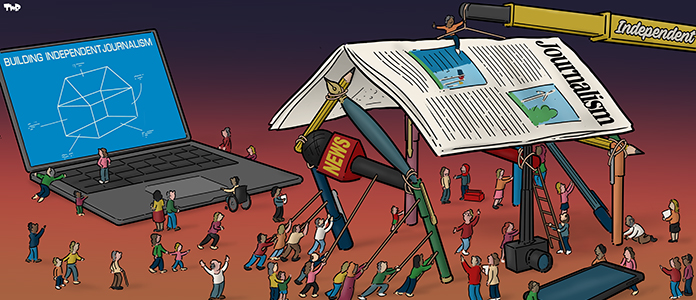Few would dispute that the early years of the internet were promising. But exactly when those early years ended is the subject of some disagreement. In 2011, the Arab Spring was widely considered a social media revolution, in which the democratising power of the internet could enable activists and freedom-loving citizens bring down dictators.
Around the same time, WikiLeaks demonstrated the capacity of the internet to help citizens hold the powerful to account. As information spread ever more rapidly across borders, some controversial sites like Gigapedia and Sci-Hub managed to democratise knowledge by allowing scholars and university students of the developing world to access books and articles that would otherwise be locked behind the paywalls of publishing monopolies.
Yet these examples are far from representative of the internet and its power and influence as a whole. Not only has it failed to live up to the high hopes expressed by commentators, for a number of dominant players the internet has been a means to concentrate fortunes and subjugate marginalised communities.
The “open-source ethic” of public ownership
The US tech journalist Ben Tarnoff’s recent book Internet for the People (Verso Books. 2022) begins with a historical and material assessment of the Internet. He explains how the political decisions (be they for the sake military strength in the context of the Cold War, or economic competitiveness in the 1990s), as well as the infrastructure and the physical locations of computers and cables play an important role in determining how billions of computers communicate with each other, and in turn, how the network of networks shapes the way society functions. One of the book’s strengths is that it provides a smart and well-written history of the internet’s “capitalist reorganisation” that forced the original research network into oblivion.

The internet, as we know it, could not have come about without public money (and in fact, there are still numerous contracts between the US military apparatus and Silicon Valley). Spanning from the late 1950s to the 1980s, or even beyond, the private sector would never have been able to take the kinds of risks taken by the Defense Advanced Research Projects Agency (DARPA) in the 1960s and 1970s, and employ the labour needed to make this project a reality. Supported by the long-term perspective provided by a United States government agency, and free from market pressures, the early Internet came to life as a product of a fruitful, decades-long co-creation process by thousands of engaged researchers.
Interesting article?
It was made possible by Voxeurop’s community. High-quality reporting and translation comes at a cost. To continue producing independent journalism, we need your support.
While some libertarians might see this as a waste of taxpayers’ resources, Tarnoff points out that this public ownership and financing of the project had two major benefits: on the one hand, it sheltered the project from unrealistic demands for profitability, and on the other, DARPA “enforced an open-source ethic” which meant that researchers working on the project shared the source codes of all their creations, thereby allowing others to contribute and sparking creativity.
In the 1980s, another public institution, the National Science Foundation became involved in the project, with the aim of bringing more people online – from outside of the military and experimental networks. This led to the creation of the NSFNET, the basis of a new national network: the principal data routes that interconnected the networks that formed the backbone of the Internet.
Privatisation and access for sale
The privatisation of this – thus far heavily subsidised – network was always foreseen, but it took place in a far more extreme form than planned. By 1995, NSFNET stopped the operations of its own backbone network and gave way for private players to take over its role. The idea was to create a level playing field and prepare the ground for competition between private service providers, but given that only a handful of private companies had the means to run a backbone network, the former state monopoly turned into an oligopoly of five telecommunications companies.
In the new millennium, they were joined by tech giants like Alphabet and Meta who were heavily investing in undersea cables and the creation of their own backbones. These telecom companies and the internet service providers that sold internet connections to the population soon became the “internet’s slumlords”, extracting high fees from users in America, but neglecting to reinvest them into better infrastructure. As a result, the service provided to consumers deteriorated over time.
But why did competition fail to uphold its promises? According to Tarnoff, Internet access is still treated as a luxury good by its sellers, although it has become as essential for citizens’ lives as housing and healthcare: it is “something people can’t choose not to consume”. If it was not clear before, the pandemic has made it incontestable: the internet is not just a place for socialising and recreation, it has become first and foremost a means for people to work, study, and deal with administrative questions. In such a situation, competition only makes sense for higher end customers who can pay a premium for better quality, those who are poor or live in remote areas where infrastructure is pricey are seen as too burdensome to cater for.
The “lost digitisation” of the EU
The problem described here is all too familiar in many European Union member states, where rural areas are missing out on digitalisation. In 2021, the European Commission estimated that “only 60 per cent of EU rural households have high-speed internet access, compared to the EU’s total average of 86 per cent.” In Germany, for example, news media reported that people living outside of cities (especially in the country’s formerly socialist, Eastern part) had to continue working from their offices, as the old copper wires did not make working from home feasible. Again, the reason seems to be the privatisation of the telecommunications sector: while serving inner city users with fibre-optic cables was deemed profitable enough by the service providers, extending this service to the rural populations was not.
In response, publicly or cooperatively owned community networks in some underserved regions of the United States have stepped up to provide high-speed internet access to communities that would otherwise be left behind. In rural North Dakota, for example, a handful of rural companies teamed up, with the help of state subsidies, to set up the foundation for a rural fibre network. In Detroit, a city where 60 per cent of households fall into the low-income category, the Equitable Internet Initiative uses philanthropic donations to provide free or low-cost internet access to those in need.
While large companies are trying all they can to sabotage the expansion of community networks, the issue might have gained political momentum in the US, with promises made by 2020 presidential candidates Bernie Sanders and Elizabeth Warren. But to move the issue to the mainstream, there is also a need to find sufficient funding for publicly or cooperatively owned networks.
Tarnoff sees three possible ways of doing this: the introduction of a differential internet fee structure for rich and poor, a digital services tax on Alphabet and Meta, or a tax on the “broadband cartel” that has been making extreme profits from providing access to its meagre services.
The next step: selling online activities
In the 2000s, the dominant companies of the internet became the so-called platforms that chose to monetise activity instead of access. By calling their services online platforms, companies such as Meta and Alphabet can present themselves as open and neutral spaces that serve to support the online activities of users and help them join forces for a greater good, just as they did during the pro-democratic uprisings worldwide – while in fact they seek to influence and exploit their online actions.
Tarnoff observes that eBay was the first major (and comparatively rather benign) actor that understood that the internet was not just a digital storefront, but a social medium, thus providing users with a community marketplace. Instead of trying to aggressively sell a product, eBay (and its predecessor AuctionWeb) was seemingly just a mediator between buyers and sellers, who performed many activities that facilitated the sales for free. Users were the ones who rated each other’s trustworthiness or gave each other tips on the use or shipping of goods. Like later platforms, its founder Pierre Omidyar profited significantly from the network effects the site created: the more unpaying users it had, the more valuable it became.
With time, to the role of the mediator (or “middleman”) and beneficiary of network effects was added that of a sovereign who managed people’s behaviours with rules and algorithms to avoid fraud and misuse of the platforms, but also to further increase profitability. As such, eBay, one of the very few survivors of the 2000-2001 dot-com crash, became a role model for many of the platforms that followed.
In the late 2000s, and especially in the 2010s and 2020s, the providers of platform services like Google, Facebook, Twitter, or TikTok have created more and more sophisticated online “shopping malls” for their users, where they can mingle in a controlled environment, often not even realising that they are being nudged by algorithms or human “moderators”, while almost all of their activity creates data that can be monetised. As the author puts it, “Data is their organi[s]ing principle and essential ingredient.”
The ills of the shopping mall internet
The massive amounts of data harvested by these online “shopping malls” drove the evolution of a number of new commercial practices on the internet. While often built around intrusions into users’ privacy, data harvesting, as well as shady (and often unrealistic) promises about what their services were capable of, online “shopping malls” have succeeded in attracting money from investors and other big businesses.
The most obvious example is the surveillance-based advertising service many platforms offer. Despite increasing evidence of an online attention crisis, Google, Facebook, and a small number of other tech giants capture the majority of advertising revenues worldwide. Another well-known case is Uber, the ride-hailing and delivery company whose services turned workers into algorithmically controlled wage-slaves. The company continues to lose billions of dollars each year, yet investors keep pouring money into it.
Tarnoff envisions an internet populated with a set of decentralised platforms, whose servers would be run independently, but could be interconnected through open protocols.
Far from the empowerment, democratic access, and horizontal connection promised in the early days, on the platformised, shopping-mall-style internet, most of the inclusion is predatory. This means that although marginalised groups are afforded greater opportunities to participate in the digital environment than they had in the pre-platform world, their exploitation continues under these new conditions, as many of the risks that were previously taken by employers are being shouldered by employees. Those working for Uber, food delivery companies, or other players of the platform economy, for example, lose most of their protections, as they officially count as self-employed subcontractors, while they are constantly being bossed around by some algorithm.
Another predatory aspect of platforms comes to the fore when we ask about the “who” of the involvement in platforms, not just the “how”. Social media amplifies racist content, propaganda and conspiracy theories for the simple reason that they generate more traffic and engagements by users. Of course, too much Nazi content might alienate mainstream users and advertisers, thus platforms find themselves in a constant balancing act. They might remove the account of the former US-president when he ignites a bloody uprising, while ignoring other blatantly racist content.
Can we fix it?
Tarnoff believes that the source of all these problems is the for-profit turn of the internet, described in his book, that shaped the way in which the dominant online actors have behaved over the last two decades. To bring about change, the root causes need to be addressed, so that ordinary people can finally participate meaningfully in the online environment.
As possible solutions, he recommends measures to tame the internet and create real public spaces. Common sense would suggest creating new rules or reducing the market power of the dominant players. Under President Joe Biden, two proponents of strengthened antitrust enforcement have gained prominence in the US: legal scholar Lina Khan was made chair of the Federal Trade Commission, and antitrust lawyer Jonathan Kanter became the assistant attorney general of the Department of Justice. In the EU, the European Commission’s antitrust chief Margrethe Vestager has been trying hard in the last few years to limit the market power of tech giants.
While it may not go far enough, the EU’s Digital Services Act has tightened rules for the large online players. At the same time, Tarnoff believes that antitrust measures, even if they are well designed, will not do the job alone, as they ultimately increase competition on the technology market, thereby making the situation worse. A slight increase in the number of players can ignite a surveillance war, in which platforms will do all they can to increase the amount of data that can be extracted from users, undermining any efforts to moderate content or initiatives that might improve the lives of online communities.
Tarnoff’s choice of response would be deprivatizing the internet: building on some of the antitrust measures, he would provide alternatives to current platforms. He envisions an internet populated with a set of decentralised platforms, whose servers would be run independently, but could be interconnected through open protocols. A prime example of this model is the social network Mastodon, or the small-scale online communities Ethan Zuckerman is experimenting with at the University of Massachusetts.
The objective would be for community members to decide themselves about the rules that guide their interactions, enforce community guidelines together, and even make decisions about the use of the data that was created by their activities. In the end, this would be a new approach to the internet, in which users become genuine co-creators.
As appealing as this thought experiment may sound, for now, it is hard to see how this deprivatized internet could become reality. It is beyond the scope of the book to assess how the political momentum may be created for change in the digital environment but it is clear that we are not even close. Politicians in both Europe and the US have called for the breaking up of tech monopolies; Joe Biden openly spoke about tech giants contributing to excess deaths in the pandemic and the European Parliament gave a platform to Facebook whistleblower Frances Haugen, yet the position of tech giants is largely unchallenged on both sides of the Atlantic.
These companies have excessive lobbying power; and Alphabet, Meta, or Amazon will only play along with rules created by regulators as long as they can be reconciled with their profit motives. Legislative proposals like the Digital Services Act can provide some remedy, but they are not game changers. In the long-run, politicians, policymakers, and philanthropists need to go further, take stock of what is being done on the grassroots level, join forces with tech activists, and acknowledge the importance of investing in the alternative: democratically governed online services that can lead to what Tarnoff calls “an internet where markets matter less”.












